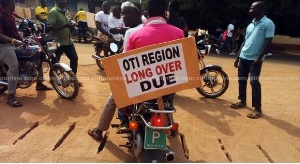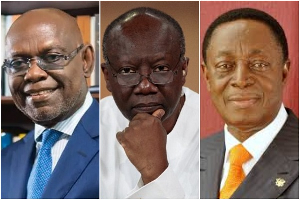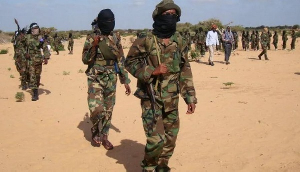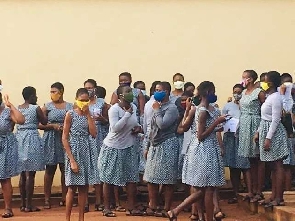The attempt to tribalise the creation of regions, particularly the Oti Region, is creating more tension, apprehension and will prove counter-productive. After all, when the Oti Region campaign gained momentum, Togbega Gabusu of Hohoe (Gbidzigbe), no doubt with the support of his subjects and Ewes within the Oti enclave, was a main supporter, with the induced, clearly now false, hope that Hohoe would be the capital of Oti Region. Then, they even have a map which included the Peki areas (Gbinyigbe), thus including the whole Gbi areas in the Oti Region.
It was only when the Hohoe area was excluded (not to mention the Peki areas not even in their thoughts), with portions of the Hohoe District – Lolobi, Akpafu, Santrokofi - homes of non-Ewes - carved out to be added to the Oti Region, that it clearly assumed an ethnic dimension and became clear to Ewes in general and the people of Akpafu, Lolobi and Santrokofi-Bume (who also were inclined to join if the whole Hohoe District is included in) that other ulterior motives were driving some instigators, motives which were there all along expressed in veiled tones and very openly in common with the corollary on the national plane which demonises and vilifies Ewes I had written many times about: that southern Ewes have been denying development to those in the northern VR and we don’t want to be with them anymore!
This anti-Ewe politics because of the PNDC even created an intra-Ewe divide, with some Ewes from the central VR forming their own anti-PNDC group and identifying Anlos as the problem Ewes to be dealt with. The late Dr Kodzi even wrote a book in the early ‘90s, Ghana: Worse Than Apartheid S. Africa, in which he identified the Anlos as the Ewes to be killed in response to the prevalent threats against Ewes, long before that “money-miss-road” sob Kennedy Agyapong went on air in Ghana calling on the Asantes to kill them.
How the killers would manage to identify between Anlos and non-Anlo Ewes was not clarified by Ewes pointing fingers at Anlos. No wonder some would like to be separated from the heavily demonised Ewes. The chickens are indeed coming home to roost! I wrote about these things in the following article and denounced the so-called Ewe elite’s failure to respond to these gross abuses and threats over the decades.
I have chronicled the genesis of the political anti-Ewe demonization and vilification which started with Dr Busia and his Progress Party’s bid for power, using available published material and anecdotal evidence. What I have published of it are available on the web, e.g., this one.
A 9-parts completed series in which I delved deeper into the pre-colonial origins of the malaise remains unpublished though. It is therefore not mere coincidence that the first call for the creation of the Oti Region emerged in early 1970 after the blistering anti-Ewe demonization Dr Busia and his PP unleashed on Gbedema and Ewes and subsequent sacking of mostly Ewes from the jobs. It simply was not wise to be from the VR and be identified as an Ewe if you are not.
But who is an Ewe? Or, what makes one an Ewe? I have answered this question in detail in my unpublished series so will just provide a brief answer here.
Capo’s work has led to linguists accepting to now give a new silly name, Gbe (Language), to all the people formerly identified as Ewes, grouping them into four linguistic sub-groups, that’s, Ewes, Ge-nyis, Fon and Phla Phera. (Capo, Hounkpati (1981): A Diachronic Phonology of Gbe. PhD thesis, Univ. of Ghana, Legon)
Nonetheless, the Ewe sub-group occupying Ghana and parts of Togo, still comprise of people from different ethnic backgrounds and origins, such as the returnees, who have made the Ewegbe their mother tongue even though having different cultural practices. A large proportion of Ewes therefore come from the Ga-Adangme, Akan, Guan and people of other origins. Those from the Ga-Adangme and Anyi or Ane origins who intermarried with Ewes in Togo have been classified into the Ge-nyi sub-group (formerly referred to as Mina-Ewes) centred around southern Togo and are the source of the “Ayigbe” nickname for all Ewes.
Some of the Anlo clans, for instance, comprise of people of Ga-Adangme origins but everyone sees himself or herself as Anlo, as membership of a clan is just by mere incidence of birth, with siblings having children belonging to different clans. So it is with ethnic group membership too in the patrilineal system VR. If say a Guan woman marries an Ewe man, the off-springs are deemed to belong to the father’s identity, but if the brother of that Guan woman marries an Ewe woman, the off-springs take the brother’s Guan identity and cultural observances.
Given the high level of mixing and intermarriages spanning centuries, there may be only few Ewes without mixed blood from other ethnic groups. That is why we have Ewes with Ga-Adangme and Akan names, being proudly people of many heritages [and land] they can lay claim to.
ETHNIC GERRYMANDERING
By and by, the Oti Region creation bid has assumed an ethnic agenda to separate Ewes from others perceived as non-Ewes under the NPP’s implementation of the whole idea. It might have been different under the NDC, probably including the whole of the Hohoe District at least, if not the Peki areas too as Togbega Gabusu wanted but who knows? It is thus the NPP that has introduced the anti-Ewe element and ethnicity into the Oti Region creation and some Ewes have seized upon this to be making claims that it was all along an Akan or NPP plot to create an Akan power enclave in an area Ewes see as their sphere of influence and space for operation long before the British took over the area. Claims have been made that Ewes in the proposed Oti Region area are even a sizeable proportion of the population there.
I don't know how true this is but if true, since they are hopefully registered voters there, I presume, if they don't want a split, they should simply turn up in their numbers, together with all the Guans, Konkombas, Nchumurus, Buems, Nanumbas, Likpes, Lolobis, Akpafus, etc., who do not want to be led to Kontsiabu for gold dust all over again and vote No. 80% Yes is needed to win in order to create a new region. Or, will they be prevented from voting on grounds that they were not originally “natives” of the area even though the area has been their home for ages, predating colonialism for many of them?
What about Akans and others, e.g., the vast influx of Konkombas during their conflicts up north, who even came much later than them? Any attempts to intimidate and disenfranchise Ewes or others living in the area will automatically nullify any referendum held there as legitimate and binding. The thorny decision to defranchise the rest of the Voltarians outside the Oti enclave is even disconcerting, to put it mildly.
Ewes have been settling in those areas long before Akan fugitives, refugees and eventually invaders started moving into the present VR. The historical records are there but I am disappointed people are spewing untruths and refusing to mention the unwholesome truths in our chequered history together. Take Santrokofi for example; it comprises of the original Bale people and Akan fugitives from as far as Wenchi who fled there after the Asantes defeated the Bonos! Together, they evolved a new dialect, a mixture of Bale and Twi. Same for the Chokosis who are also classified as Akans.
I have chronicled the peopling of the VR by the newcomers in the unpublished piece but this is found in the three volume publications by the Organisation for Research in Eweland (ORE) and other books. I think it is in place to delve a little into that, as it’d serve to explain the angst and disquiet Ewes and some are expressing against the Oti Region creation, even if they had been amenable to the idea before or been part of all the consultations, as Togbe Afede is being accused of, as if being a part of a consultative meeting meant one has automatically granted approval to its final decision. That is just one of the sloppy thinking that characterises this whole brouhaha.
Present Akwamufie in the Eastern Region was originally inhabited by Ewes before the Akwamu fugitives fled there in 1730 when the combined forces of the Gas and Akyems defeated them. Interesting, the Nkonyas - Guans - also fled there earlier from the Nsawam area after the Akwamus defeated them and turned their capital Nyanoase into theirs. When the free-booting Akwamu fugitives arrived after their surprised defeat, the Nkonyas and the remaining Ewes fled deeper and deeper into the VR. Of course, the Akwamus followed them and the sad tale of slave raiding and plunder that happened in the area known as Krepi in the European records is in the history books. One can read all about it in Prof. Emeritus D.E.K. Amenumey’s The Ewe in Pre-colonial Times.
I had read of some false claims that the area belonged to the Akyems. In actual fact, some Akyems also arrived as fugitives after their crushing defeat by the Asantes under Asantehene Osei Kwame in 1764. Some settled as far as Kpessi in present Togo. When the last stanza of the lamentation cry of the Road to Kontsiabu is written, then I shall continue with the tale of what happened that fateful day the historians have been battling to unravel for decades..
Even after Kwadwo Dei I of Peki decided to stop being an Akwamu lackey and enforcer and revolted in 1833 and led the war of liberation against the Akwamus and their allies, sporadic wars continued until the Sagrenti War of 1874, partly caused by the Akwamu allies, the Asantes under Adu Boafo invading the Weme (Krepi) area and taking the missionaries (the Ramseyers), and other whites hostages for ransom from Ho-Kpodzi, put a stop to it. More Akyems came with the Akyem war leader Dompey in the 1860s to assist the Weme people to fight off the Asantes, Akwamus and their local allies, who by the way, included others in the VR besides the Anlos
The Peace Treaty signed in 1874 at Dzelukope because the Anlos fought on the side of their Akwamu and Asante allies, which the father of my own great grandfather who happened to be the father of Torgbui Sri II too, was one of the leaders of the Anlo delegation, explicitly banned the Asantehene from ever claiming suzeraingty over the area under Asante hegemonic influence in what became known as the Transvolta Togoland (TVT). It is therefore an anomaly for the chief of Worawora, or any chief in the VR, to be swearing allegiance to the Asantehene. The Paramount Chief of Buem was right to have opposed this move when it started. After all, they were there as an invading force and occupiers who were finally defeated soundly. It is sheer revanchism for some to renew allegiance to the Asantehene. So what would be the next chapter in the unfolding scenario, say in some twenty years? A “substantial demand” and petitions by some in the Oti Region and Ashanti Region to unite and be under the golden stool which demand shall be met by a referendum this time in both regions as they say is prescribed by the Constitution?
In fact, it might be that in the near future such a substantial demand is made in New Juaben in the Eastern Region to be carved out to be added to the Ashanti Region where their ancestors fled from and the musical chair of creating regions can then get merrier. Indeed, Christian Atsu the footballer when he has matured enough might also learn that he is indeed a bonafide Ewe from Agorta in Agave (not indeed an Ayigbe – those are descendants of Ga fugitives who refused to return to Accra from Glidzi and Anexo with the royal regalia) before his ancestor
Atsu was settled at Dodoekope-Keseve by his twin brother Ahavi Etse (Ahaviatse) founder of the Kudjragbe clan who owned much of the lands from Big Ada downwards upon which the real Ada fugitives from Lorlorvor and Okorhuem settled. He may then lead his people to make a substantial demand to be reunited to his kinsmen across the Volta.
Of course, which demand we Anlos shall heartily welcome with our own substantial demand and petition to be reunited to our breakaway kinsmen. We already got back the war god which was the basis of our early disputes and schism with our vanguard kinsmen the Agaves of the Dorgbo migrants from Notse. That is what will happen when you summoned fish mongers and school drop out hairdressers to draw a constitution and make laws for you in your Parliament! Modern governance is not for illiterates and semi-illiterates even if they are loaded with money!
Anyway, digression aside, the Sagrenti War happened at a time when the Bekwais who actually controlled the northern VR area were having one of their rebellions against Manhyia and not even recognising the Asantehene as their leader. It made sense then to pacify the Wemes and the original inhabitants of the areas who became victims of the Akan invaders who just wanted to massacre and drive off the Akans.
The British did their best to stop the revenges not only against the Akans but also against others like the Taviefes who supported the Asantes even when that led to many ending up at Kontsiabu as captives themselves but it was difficult controlling the people. They later conveniently gave the area now known as the TVT to the Germans in 1884 but were still in control trying to separate the warring parties by 1888, as recorded in Jakob Spieth’s The Ewe People, which gave very succinct accounts of the events I am just mentioning in passing.
The TVT was thus part of the British Protected Area before becoming part of the German colony of Togo and thus a British creation. This fact is being glossed over and lied about by some proponents of a fictional Western Togoland who must also be checked and put in place. George Padmore was right in titling the chapter he devoted this issue in his Ghana Revolution Irredentist Nationalism (p.152).
The shenanigans associated with the creation of the Oti Region have thus touched ancient sore nerves and are re-opening old wounds. The protagonists are not mentioning them but we hear allusions being made to them, with the usual myths covering them. When some put on war garments and claim that they had not be defeated before, falsely of course - everyone has been defeated before - what do they mean?
I hope I have not only muddied the waters furthermore but touched the proverbial scrotum of the spider (Ayiyiwovo), in order to provoke serious reflection and debate about us. Then, we may indeed open the Pandora’s Box of Nasties and let the chips fall where they may.
Diaspora News of Wednesday, 21 November 2018
Source: andy c. y. kwawukume
The Brouhaha about the creation of the Oti Region; The Ethnic Imbroglio - Part 2
Entertainment












